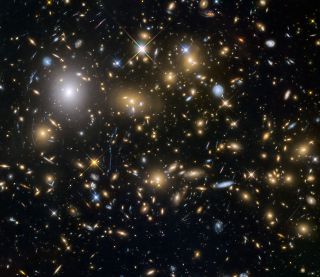Here's How Much Starlight Has Been Created Since the Beginning of the Universe

Hidden in the darkness among the stars is all the light that the universe has created since the Big Bang.
Now, scientists think they know approximately how much light that is. Since their birth a couple million years after the Big Bang, stars have produced around 4 x 10^84 photons, or particles of light, according to new measurements reported today (Nov. 29) in the journal Science.
Most of the light in the universe comes from stars, said Marco Ajello, study co-author and an astrophysicist at Clemson University.
Here's what happens: Stars like our sun are powered by nuclear reactions in the core, where hydrogen protons are fused together to create helium. This process also releases energy in the form of gamma-ray photons. These photons have a hundred million times more energy than the ordinary photons we see as visible light. [Big Bang to Civilization: 10 Amazing Origin Events]
Because the core of the sun is very dense, those photons cannot escape and instead keep bumping into atoms and electrons, eventually losing energy. Hundreds of thousands of years later, they leave the sun, with about a million times less energy than visible light, Ajello said.
The light that we can see comes from photons created by stars in our own galaxy, including the sun. Measuring all that other light in other parts of the universe — hidden in the dark sky among the stars we can see — is "difficult, because it is very, very dim," Ajello told Live Science. Indeed, trying to see all of the light in the universe would be like looking at a 60-watt lightbulb from 2.5 miles (4 kilometers) away, he added.
So, Ajello and his team used an indirect method to measure this light, relying on data from NASA's Fermi Gamma-ray Space Telescope, which has been orbiting the Earth since 2008. The researchers looked at gamma-rays emitted from 739 blazars (incredibly bright galaxies with black holes that shoot gamma-rays in our direction) and one gamma-ray burst (an extremely high-energy explosion) to estimate how much starlight existed during various epochs of the universe — the farther away the source of the gamma-rays, the longer ago the time.
Sign up for the Live Science daily newsletter now
Get the world’s most fascinating discoveries delivered straight to your inbox.
As they pass through the universe, the photons in these gamma-rays interact with the "extragalactic background light," a fog of ultraviolet, optical and infrared photons produced by stars. This process transforms the photons into electrons and their antimatter partners, positrons. By detecting these small changes, Ajello and his team were able to estimate how much starlight or "fog" there was at various times.
The scientists found that stars formed at the highest rate around 10 billion years ago and that after that, star formation lessened immensely. The total amount of starlight ever produced, "is not very important," Ajello said.
In fact, the 4 x 10^84 number the researchers calculated for the total number of photons produced could be about 10-fold too low. That's because it doesn’t include photons in the infrared spectrum, which have a lower energy than visible light, Ajello said.
The more exciting result is that the researchers could calculate how many and what types of photons existed during various epochs of the universe, starting from the (almost) beginning. Ajello and his team constructed a starlight history spanning more than 90 percent of cosmic time. To construct the other 10 percent, the very, very beginning of starlight, "we would need to wait [for] maybe 10 more years of observation," Ajello said.
A snapshot of the starlight created during the universe's infancy could come from the massive James Webb Space Telescope, which is estimated to have a 2021 launch, Ajello said.
This is "another milestone of the Fermi team," Elisa Prandini, a postdoctoral fellow in the department of physics and astronomy at the University of Padova in Italy, wrote in a perspective piece in the same issue of Science. Prandini, who was not involved in the current research, also ended her perspective with a mention of the James Webb Space Telescope and the more "direct" measurements it could yield.
- Fallen Stars: A Gallery of Famous Meteorites
- Large Numbers That Define Our Universe
- 11 Fascinating Facts About Our Milky Way Galaxy
Originally published on Live Science.

Yasemin is a staff writer at Live Science, covering health, neuroscience and biology. Her work has appeared in Scientific American, Science and the San Jose Mercury News. She has a bachelor's degree in biomedical engineering from the University of Connecticut and a graduate certificate in science communication from the University of California, Santa Cruz.
Most Popular


